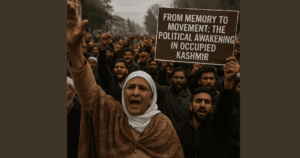Kashmir’s Political Awakening: 7 Shocking Truths That Will Empower the Freedom Movement
The political struggle in Indian-occupied Kashmir is deeply rooted in decades of resistance, identity, and memory. Since 1947, India has strategically worked to suppress this movement, manipulating leaders like Sheikh Abdullah and crushing dissent through laws such as the PSA and UAPA. The revocation of Article 370 in 2019 marked a turning point, eroding Kashmir’s legal autonomy and sparking concerns of demographic changes. With peaceful voices silenced and leaders jailed, political space has nearly vanished.
Yet, the spirit of resistance survives in the hearts and homes of Kashmiris—passed through stories, poems, and silent acts of defiance. Unlike other movements, Kashmir’s internationally disputed status and the legacy of UN resolutions give it a unique dimension. Cultural resilience, diaspora engagement, and generational memory now form the backbone of its resistance. In a heavily militarized landscape, the idea of freedom remains alive—not in institutions, but in people.

Kashmir’s Political Awakening: 7 Shocking Truths That Will Empower the Freedom Movement
Kashmir’s struggle to define its political identity has often been perceived by India as a threat rather than a legitimate movement. Since the partition of India and Pakistan in 1947, India has avoided accountability for the region’s unrest, instead blaming historical rulers like the Dogras. This narrative allowed India to position itself as a savior rather than an occupier, masking its gradual tightening of control over the region.
In the early years, India sought alliances with local leaders to legitimize its presence. Sheikh Abdullah, a prominent Kashmiri figure, was initially seen as a bridge between Kashmiris and India. Released from prison and aligned with India’s first Prime Minister, Jawaharlal Nehru, Abdullah’s collaboration raised hopes for autonomy. Over time, however, this partnership unraveled, revealing a strategy to integrate Kashmir into India’s political framework while eroding its autonomy.
The Kashmiri struggle is complex—rooted in cultural pride, political ambition, and a demand for dignity. For decades, calls for rights and recognition were met with suppression. The situation escalated in 2019 when India revoked Article 370 of its constitution, stripping Jammu and Kashmir of its special status. This move dissolved the region’s limited autonomy, sparking outrage and deepening distrust.
Today, expressing dissent in Kashmir carries severe risks. Peaceful activists, journalists, and politicians face imprisonment under laws like the Public Safety Act (PSA) and the Unlawful Activities Prevention Act (UAPA). In 2023, Indian authorities confiscated the properties of over 190 Kashmiris—a tactic widely viewed as intimidation. The goal extends beyond stifling dissent; it seeks to erase Kashmir’s historical identity and collective memory. Despite a heavy military presence of nearly 900,000 troops, the desire for self-determination persists.
Divided Voices and Broken Promises
Historically, India has fragmented Kashmiri resistance by co-opting local voices. Political groups willing to engage with New Delhi were absorbed, diluting demands for independence. A pivotal moment came in 1987, when elections were allegedly rigged to sideline the Muslim United Front (MUF), a popular coalition. Public anger over this betrayal fueled mass protests and eventually led to armed resistance in the 1990s. The All Parties Hurriyat Conference (APHC), formed to unite Kashmiris under a peaceful self-determination movement, faced relentless state crackdowns, internal splits, and diminished influence.
Resistance Beyond Politics
Kashmir’s defiance is not confined to protests or politics. It lives in everyday acts of resilience—elders sharing stories of resistance with grandchildren, funerals transforming into silent protests, and poets writing verses in prison. These subtle acts preserve a collective memory that state forces cannot easily erase.
The Global Dimension
Unlike other regional movements in India, Kashmir’s status is internationally recognized as a dispute. The United Nations has acknowledged the need for a resolution, though little progress has been made. The revocation of Article 370 intensified fears of demographic change, as India began granting residency permits to non-Kashmiris—a move many view as an attempt to alter the region’s Muslim-majority identity and weaken its political voice.
Survival in the Face of Repression
For Kashmir’s resistance to endure, three elements are critical:
- Adapting Strategies – New approaches are needed to navigate India’s oppressive tactics, including digital activism and global advocacy.
- Preserving Culture – Art, literature, and education keep Kashmiri identity alive, resisting erasure.
- Mobilizing the Diaspora – Kashmiris abroad play a vital role in amplifying the movement’s visibility and legitimacy.
A Quiet Defiance
India’s domestic challenges—caste discrimination, religious divides, and regional conflicts—expose its fragile unity. In Kashmir, where open protest is met with violence, resilience thrives in quiet ways. The transmission of history through generations becomes an act of rebellion.
Kashmir’s struggle is not marked by grand gestures but by an unyielding spirit. Memory, culture, and an unwavering belief in justice fuel this resistance. No matter the force used to suppress it, the idea of freedom—rooted in identity and history—refuses to fade. In Kashmir’s silence, the cry for dignity echoes loudest.
You must be logged in to post a comment.